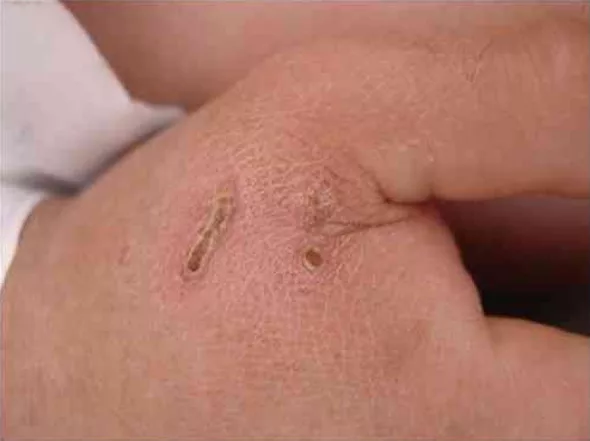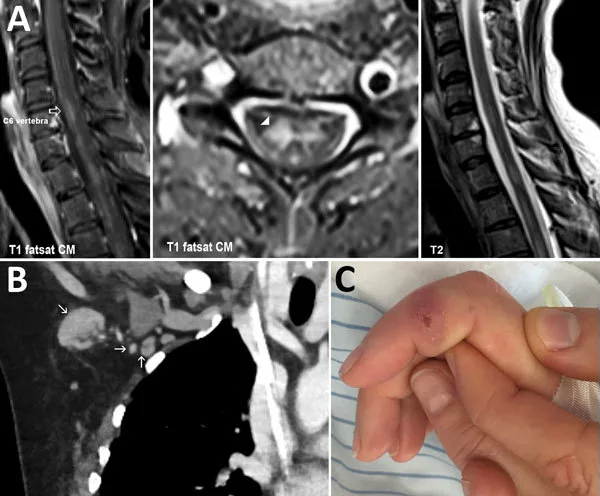As the name indicates, cat scratch disease (CSD) or cat scratch fever (CSF) is a rare bacterial infection caused by contact with domestic cats. It is also known as Subacute regional lymphadenitis. The incidence of the disease in the US (from 2005 to 2013) was found to be 6.4 cases/100,000 population.1Nelson, C. A., Saha, S., & Mead, P. S. (2016). Cat-scratch disease in the United States, 2005–2013. Emerging infectious diseases, 22(10), 1741. The causative agent for this infectious disease is Bartonella henselae bacteria. The disease develops if a cat (infected with the Bartonella bacteria) licks an open skin wound or bites/scratches you. In most patients, it causes skin rash, lymph node swelling, and fever, etc. However, the disease can have severe consequences in immunocompromised patients. The disease is self-resolving (goes away on its own within a few days) and does not require any treatment. However, when required, doctors treat it with antibiotic therapy.
Cat Scratch Disease Symptoms
Typical Presentations:
Swollen Lymph Nodes
The most salient feature of the disease is swelling of lymph nodes. It can present with inflammation of multiple lymph nodes across the body. In the vast majority of cases, only one node is affected, and the most frequently involved nodes lie in the axillary (armpit), epitrochlear (near elbow), head, and groin regions.
Lymphadenopathy (inflammation of lymph nodes) in the armpits and symptoms like fever and skin rash usually reveal underlying cat scratch disease. Proper clinical diagnosis and laboratory investigation are required to diagnose it.2Lin, M. V., Nguyen, N. T., Qian, Y. W., Phan, V. T., & Nguyen, Q. D. (2020). Cat scratch disease is an entity often diagnosed in the breast imaging department during axillary lymph node assessment. Cureus, 12(7).
Inguinal lymphadenitis can not only lead to lymph node enlargement but may also cause painful ulcer formation in the region.3Zhu, M., Zhang, S., Shi, Q., Sun, X., Zhang, X., Wang, H., … & Sun, M. (2022). Swollen inguinal lymph nodes with low fever and night sweat: diagnosis and treatment of case of cat-scratch disease lymphadenitis with sinus formation. Heliyon, 8(9). These lymph nodes are painful and can cause significant discomfort.
As lymph node swelling is an evident feature, experts advise clinicians to consider cat scratch disease in pediatric patients with regional lymphadenopathy.4Fan, K., Cheng, Y., & Hao, S. (2024). Lymph node histology and metagenomic sequencing in a child with cat scratch disease. QJM: An International Journal of Medicine, hcae188.
Skin Bumps/Rash
Another notable presentation of the bacterial infection is the formation of skin symptoms. Bumps or blisters form at the site of the bite or scratch. Bumps and blisters generally appear 3-10 days after exposure. However, lymph node swelling may develop several days (or weeks) later.

In most cases, a papule (raised skin spot that may be cystic or solid) is the first symptom to appear (before lymphadenopathy) at the initial wound site.5Nemade, S. V., Shinde, K. J., Nemade, S. V., & Shinde, K. J. (2021). Cat Scratch Disease. Granulomatous diseases in Otorhinolaryngology, Head and Neck, 79-85.
Fever
Diagnosing this rare disorder is an arduous task for clinicians. Like most bacterial infections, low-grade fever (below 100.4℉) is a manifestation of cat scratch disease, too. Some experts believe that CSD rarely presents with a fever of unknown origin that may last for weeks (median duration of 4 weeks).6Landes, M., Maor, Y., Mercer, D., Habot-Wilner, Z., Bilavsky, E., Chazan, B., … & Giladi, M. (2020). Cat scratch disease presenting as a fever of unknown origin is a unique clinical syndrome. Clinical Infectious Diseases, 71(11), 2818-2824. A study concluded that CSD has a wide spectrum of clinical pictures, of which fever is an integral component.7Mazur-Melewska, K., Mania, A., Kemnitz, P., Figlerowicz, M., & Służewski, W. (2015). Cat-scratch disease: a wide spectrum of clinical pictures. Advances in Dermatology and Allergology/Postępy Dermatologii i Alergologii, 32(3), 216-220.
Body aches
Musculoskeletal complications are pretty common in CSD patients. According to a detailed study, patients experience the following symptoms:
- Myalgias, i.e., muscle pains in 5.8% of cases
- Joint/bone pains, i.e., arthralgia in 5.5% of cases
Tendinitis and neuralgic pain were also reported by a small number of participants. The study concluded that musculoskeletal manifestations of cat scratch fever are more common than previously thought.8Maman, E., Bickels, J., Ephros, M., Paran, D., Comaneshter, D., Metzkor-Cotter, E., … & Giladi, M. (2007). Musculoskeletal manifestations of cat scratch disease. Clinical infectious diseases, 45(12), 1535-1540. Painful muscles and joints limit body movements and contribute to a reduction in quality of life.
Fatigue & Headache
In addition to lymph nodes and skin presentation, patients have to face issues like fatigue and headache. Minor systematic issues like headaches, loss of appetite, fatigue, and general discomfort are less commonly seen in patients.9Somal, S., Kiran, B., Naqvi, F. Z., Mustafa, Z., Shahzad, M. N., Shafique, Z., & Zafar, M. A. (2023). Cat scratch disease. Zoonosis, Unique Scientific Publishers, Faisalabad, Pakistan, 4, 510-519.
Other uncommon symptoms of CSD include loss of appetite and unwanted weight loss.
Atypical Presentations:
Atypical presentations of CSD are associated with an increased risk of hospitalization. Victims of these atypical manifestations are mostly women. The common issues include ocular issues (48.7%) such as retinitis and conjunctivitis, i.e., inflammation of eye layers. Second to eye problems were liver and spleen enlargement (present in 24.6% of patients). Neurologic complications were seen in about 14% of cases. Other rare presentations included endocarditis, osteomyelitis, and erythema nodosum.10Nawrocki, C. C., Max, R. J., Marzec, N. S., & Nelson, C. A. (2020). Atypical manifestations of cat-scratch disease, United States, 2005–2014. Emerging infectious diseases, 26(7), 1438.
Hepatosplenic Bartonellosis
It is a rare consequence of CSD that causes fever, abdominal pain, and liver/spleen enlargement (hepatosplenomegaly).11Sharma, R., Arshad, A. M., Sardar, S., & Zafar, A. (2021). Hepatosplenic bartonellosis in an immunocompetent teenager: an atypical presentation of cat-scratch disease. Cureus, 13(2).
Neuro-opthalmological Consequences
Cat scratch disease can cause a lot of trouble in immunocompromised individuals. Neuro-opthalmological consequences in patients with weak immunity include:
- Parinaud oculoglandular syndrome (eye condition similar to pink eye)
- Uveitis (inflammation of the inside of the eye)
- Vitritis (inflammation of the vitreous body of the eye)
- Retinitis (inflammation of the retina)
- Optic neuritis (inflammation of the optic nerve)
- Retinochoroiditis (inflammation of the retina and choroid)

Neurological abnormalities caused by the zoonotic infection included:
- Encephalopathy (brain dysfunction)
- Transverse myelitis (inflammation of the spinal cord)
- Cerebellar ataxia (inflammation of the cerebellum)
As expected, neurological implications in the immunocompromised can prove to be fatal, especially in HIV patients.12Jurja, S., Stroe, A. Z., Pundiche, M. B., Docu Axelerad, S., Mateescu, G., Micu, A. O., … & Docu Axelerad, A. (2022). The clinical profile of cat-scratch disease’s neuro-ophthalmological effects. Brain Sciences, 12(2), 217. There also have been case reports of CSD-induced sepsis in immunocompromised patients.13James, S., & Thozhuthumparambil, K. P. (2021). Cat scratch disease sepsis in an immunocompromised patient. BMJ Case Reports CP, 14(7), e239932.
Some patients also report having abdominal pain, backache, and prolonged fever.
Cat Scratch Disease Causes
Flea bites are responsible for the transfer of B.henselae to cats. Many times, kittens suffer from the bacterial infection without any evident symptoms. The bacteria from cats can transfer when their saliva comes in contact with humans. You can get the infection from a cat in the following ways:
- If a cat licks your open skin wound.
- If an infected cat bites you.
- If an infected cat scratches your skin.
Until now, there have been no reports of direct transmission of B. henselae from fleas to humans (via flea bites).
Risk Groups:
The following people are at a greater risk of acquiring the infection:
- Cat keepers
- Children under the age of 15
- Individuals with weak immune systems (Hepatitis, AIDS, and transplant patients)
Cat Scratch Disease Diagnosis
History & Physical Exam:
After taking a complete history of your symptoms, your doctor will perform a physical examination. In the exam, your healthcare provider will look for the telltale signs of the infection, i.e., swollen lymph nodes (especially axillary) and any skin rash or bumps. Doctors feel (palpate) the lymph nodes to check for swelling, tenderness, and pain. The healthcare provider may also search for any scratches or wounds on the skin.
Diagnostic Tests:
As it is a rare disorder, diagnosis is difficult. Some of the diagnostic tests that aid in conclusion include:
Blood test
Doctors take a blood sample and send it to the lab to check for the presence of the B. henselae bacteria. Lab technicians use the Polymerase chain reaction (PCR) test to detect the bacteria.
Lymph test
Your doctor may opt to aspirate fluid from your lymph node. The fluid sample is tested for pathogenic bacteria.
Differential Diagnosis:
Swelling of the lymph nodes and fever raise concerns among most patients. A lot of patients fear it to be cancer. Multiple conditions have similar presentations and fall under the category of differential diagnosis of cat scratch disease:
Cat Scratch Disease Vs. Toxoplasmosis
CSD and toxoplasmosis have similar symptoms and are transmitted to humans through domestic cats. However, toxoplasmosis is a more serious disease, which, unlike CSD, can spread to humans via cat feces. Toxoplasmosis can cause severe symptoms in pregnant women.
Other conditions having similar manifestations include:
- Brucellosis (causes swollen lymph nodes and flu-like symptoms)
- Lymphadenitis (inflammatory disease of lymph nodes)
- Lyme disease (tick-borne infection that causes skin rash+flu-like symptoms)
Cat Scratch Disease Treatment
For the most part, cat scratch disease goes away on its own in immunocompetent patients. However, it may take the skin lesions (bumps and blisters) around 1-3 weeks to go away, while lymph node swelling can take 2-4 months to completely resolve. You may need to get a very large/painful lymph node drained at a clinic (as it may persist for 6 months to 1 year). During recovery, you can try warm compressions (of the nodes) to speed up the healing process. Over-the-counter analgesics can help reduce pain.
Healthcare providers only prescribe medications in serious cases of cat scratch fever and immunocompromised individuals.
Cat Scratch Disease Medications:
The most common cat scratch disease medicine is azithromycin. Antibiotic therapy with azithromycin shows great results. In a clinical study, empirical treatment with azithromycin led to the complete resolution of symptoms (especially of skin) within just 7 days.14Chang, L. C., Nazariah, N., & Keng-Yin, L. O. H. (2021). A CAT SCRATCH DISEASE CUTANEOUS LESION RESPONSE TO EMPIRIC ANTIBIOTIC TREATMENT: A CASE REPORT: Cat Scratch Disease Cutaneous lesion. The Southeast Asian Journal of Tropical Medicine and Public Health, 52(5), 630-634. Azithromycin results are quick and clinically reliable.15Poulsen, C. B., Penninga, L., Bjerring, P., & Mikkelsen, C. S. (2024). Cat scratch disease. J Clin Images Med Case Rep, 5(2), 2879.
Other alternatives to azithromycin that can work well for CSD patients include:
- Trimethoprim-sulfamethoxazole
- Ciprofloxacin
- Rifampin
- Tetracycline
One study concluded that azithromycin is the ideal choice for cat scratch disease in pediatric patients and drug combinations like trimethoprim/sulfamethoxazole can be considered as safe alternatives to azithromycin.16Shorbatli, L. A., Koranyi, K. I., & Nahata, M. C. (2018). Effectiveness of antibiotic therapy in pediatric patients with cat scratch disease. International journal of clinical pharmacy, 40, 1458-1461.
Cat Scratch Disease Prevention
You can adopt the following simple steps to stay safe from cat scratch fever:

- Keep your cats safe from flea bites (by keeping them indoors).
- Cover your skin wounds and avoid bites/scratches from your cat.
- Do not let cats lick your wounds or scratches.
- Wash hands after petting kittens.
- Avoid cats (or get an older cat above 1 year) if you have a compromised immune system.
Flea control measures (for cats) help reduce the number of CSD cases on a national level.17Nelson, C. A., Saha, S., & Mead, P. S. (2016). Cat-scratch disease in the United States, 2005–2013. Emerging infectious diseases, 22(10), 1741.
Final Word
Cat scratch disease/fever is a zoonotic bacterial infection caused by cat scratches/bites (or licking of wounds by kittens). Bartonella henselae bacteria is the causative agent transmitted from cats to humans. The infection mainly causes mild disease with tolerable symptoms like skin bumps, rash, swollen lymph nodes, fever, etc. Rarely, it can present with atypical serious consequences (in immunocompromised patients), which include liver/spleen enlargement, eye inflammation, and neurologic complications (encephalopathy, etc.). The disease is self-limiting but takes a few days to weeks to resorb. When indicated, doctors prescribe antibiotics like azithromycin. You can prevent CSD by avoiding contact with cat saliva and preventing bites/scratches.
Refrences
- 1Nelson, C. A., Saha, S., & Mead, P. S. (2016). Cat-scratch disease in the United States, 2005–2013. Emerging infectious diseases, 22(10), 1741.
- 2Lin, M. V., Nguyen, N. T., Qian, Y. W., Phan, V. T., & Nguyen, Q. D. (2020). Cat scratch disease is an entity often diagnosed in the breast imaging department during axillary lymph node assessment. Cureus, 12(7).
- 3Zhu, M., Zhang, S., Shi, Q., Sun, X., Zhang, X., Wang, H., … & Sun, M. (2022). Swollen inguinal lymph nodes with low fever and night sweat: diagnosis and treatment of case of cat-scratch disease lymphadenitis with sinus formation. Heliyon, 8(9).
- 4Fan, K., Cheng, Y., & Hao, S. (2024). Lymph node histology and metagenomic sequencing in a child with cat scratch disease. QJM: An International Journal of Medicine, hcae188.
- 5Nemade, S. V., Shinde, K. J., Nemade, S. V., & Shinde, K. J. (2021). Cat Scratch Disease. Granulomatous diseases in Otorhinolaryngology, Head and Neck, 79-85.
- 6Landes, M., Maor, Y., Mercer, D., Habot-Wilner, Z., Bilavsky, E., Chazan, B., … & Giladi, M. (2020). Cat scratch disease presenting as a fever of unknown origin is a unique clinical syndrome. Clinical Infectious Diseases, 71(11), 2818-2824.
- 7Mazur-Melewska, K., Mania, A., Kemnitz, P., Figlerowicz, M., & Służewski, W. (2015). Cat-scratch disease: a wide spectrum of clinical pictures. Advances in Dermatology and Allergology/Postępy Dermatologii i Alergologii, 32(3), 216-220.
- 8Maman, E., Bickels, J., Ephros, M., Paran, D., Comaneshter, D., Metzkor-Cotter, E., … & Giladi, M. (2007). Musculoskeletal manifestations of cat scratch disease. Clinical infectious diseases, 45(12), 1535-1540.
- 9Somal, S., Kiran, B., Naqvi, F. Z., Mustafa, Z., Shahzad, M. N., Shafique, Z., & Zafar, M. A. (2023). Cat scratch disease. Zoonosis, Unique Scientific Publishers, Faisalabad, Pakistan, 4, 510-519.
- 10Nawrocki, C. C., Max, R. J., Marzec, N. S., & Nelson, C. A. (2020). Atypical manifestations of cat-scratch disease, United States, 2005–2014. Emerging infectious diseases, 26(7), 1438.
- 11Sharma, R., Arshad, A. M., Sardar, S., & Zafar, A. (2021). Hepatosplenic bartonellosis in an immunocompetent teenager: an atypical presentation of cat-scratch disease. Cureus, 13(2).
- 12Jurja, S., Stroe, A. Z., Pundiche, M. B., Docu Axelerad, S., Mateescu, G., Micu, A. O., … & Docu Axelerad, A. (2022). The clinical profile of cat-scratch disease’s neuro-ophthalmological effects. Brain Sciences, 12(2), 217.
- 13James, S., & Thozhuthumparambil, K. P. (2021). Cat scratch disease sepsis in an immunocompromised patient. BMJ Case Reports CP, 14(7), e239932.
- 14Chang, L. C., Nazariah, N., & Keng-Yin, L. O. H. (2021). A CAT SCRATCH DISEASE CUTANEOUS LESION RESPONSE TO EMPIRIC ANTIBIOTIC TREATMENT: A CASE REPORT: Cat Scratch Disease Cutaneous lesion. The Southeast Asian Journal of Tropical Medicine and Public Health, 52(5), 630-634.
- 15Poulsen, C. B., Penninga, L., Bjerring, P., & Mikkelsen, C. S. (2024). Cat scratch disease. J Clin Images Med Case Rep, 5(2), 2879.
- 16Shorbatli, L. A., Koranyi, K. I., & Nahata, M. C. (2018). Effectiveness of antibiotic therapy in pediatric patients with cat scratch disease. International journal of clinical pharmacy, 40, 1458-1461.
- 17Nelson, C. A., Saha, S., & Mead, P. S. (2016). Cat-scratch disease in the United States, 2005–2013. Emerging infectious diseases, 22(10), 1741.

